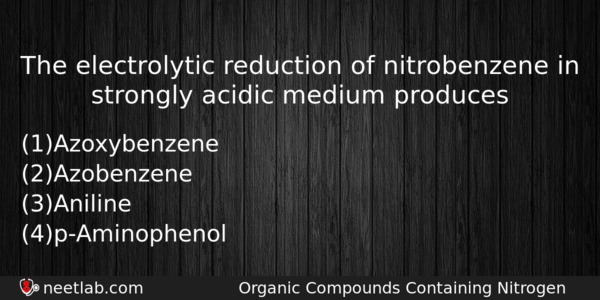| ⇦ | 
| ⇨ |
The electrolytic reduction of nitrobenzene in strongly acidic medium produces
Options
(a) Azoxybenzene
(b) Azobenzene
(c) Aniline
(d) p-Aminophenol
Correct Answer:
p-Aminophenol
Explanation:
No explanation available. Be the first to write the explanation for this question by commenting below.
Related Questions: - Which one of the following transition metals ions shows magnetic moment of 5.92
- An atom has electronic configuration 1s²2s²2p⁶3s²3p⁶3d³4s², you will place it in
- Number of chloride ions around a single sodium ion in NaCl crystal is
- Which of the following is the buffer solution
- For vaporization of water at 1 atmospheric pressure, the values of ΔH and ΔS
Topics: Organic compounds containing Nitrogen
(87)
Subject: Chemistry
(2512)
Important MCQs Based on Medical Entrance Examinations To Improve Your NEET Score
- Which one of the following transition metals ions shows magnetic moment of 5.92
- An atom has electronic configuration 1s²2s²2p⁶3s²3p⁶3d³4s², you will place it in
- Number of chloride ions around a single sodium ion in NaCl crystal is
- Which of the following is the buffer solution
- For vaporization of water at 1 atmospheric pressure, the values of ΔH and ΔS
Topics: Organic compounds containing Nitrogen (87)
Subject: Chemistry (2512)
Important MCQs Based on Medical Entrance Examinations To Improve Your NEET Score
18000+ students are using NEETLab to improve their score. What about you?
Solve Previous Year MCQs, Mock Tests, Topicwise Practice Tests, Identify Weak Topics, Formula Flash cards and much more is available in NEETLab Android App to improve your NEET score.
Share this page with your friends

Under weekly acidic conditions nitrobenzene on electrolytic reduction gives aniline but under strongly acidic conditions gives p-aminophenol